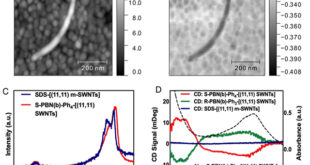Electrochimica Acta, Volume 153, 2015, Pages 574-582.
Jaqueline Pazinato1, Denize M. Hoffmeister1, Karine P. Naidek1, Eduard Westphal2, Hugo Gallardo2, Herbert Winnischofer1
- Universidade Federal do Paraná, Departamento de Química, Curitiba, Paraná, 81531-980, Brazil.
- Universidade Federal de Santa Catarina, Departamento de Química, Florianópolis, Santa Catarina, 88040-900, Brazil.
Abstract
We synthesized the amphiphilic bis(bipyridine) ruthenium complex [Ru(bipy)2Cl(L)]+ (bipy= 2,2′-bipyridine,L = 4-(4-dodecyloxyphenylazo) pyridine). The long-chain ligand contributed to the self-assembly of the complex at the liquid-air interface, enabling its deposition by the Langmuir-Blodgett technique. The UV-vis, Raman, and specular reflectance FTIR spectroscopies revealed the molecular organization in the LB films: in the free ligand LB film the alkoxyphenylazopyridine species were oriented in parallel to each other and parallel to the normal plane of the substrate, whilst in the ruthenium complex film the alkoxyphenylazopyridine species were oriented in parallel to each other and perpendicular to the normal plane of the substrate. We then prepared multilayer films consisting of layers of ligand L supporting a monolayer of the ruthenium complex and characterized them by electrochemistry. This hybrid film structure led to optimal orientation of the ruthenium centers for electrochemical response. The results indicated that the phenylazo low-lying π-orbital participated in the hopping mechanism that mediated the electron transfer in the LB films with few molecular layers.
Significance Statement
Molecular organization in few-layer films attracts special interests because it influences the interfacial properties in devices, such as sensors, solar cells, optoelectronics, and others. Such thin-films could provide better responsive devices employing fewer materials. We have been designing amphiphilic molecules that have the ability to self-assemble in the liquid-air interface and form organized Langmuir-Blodgett films. The molecular geometry of these amphiphiles determines their packing and, in some cases, the adopted arrangement is not the most favorable for electron transport or electrochemistry. In this work we report an approach to improve the electrochemical performance using hybrid LB films. These films are constituted by an inner organic layer that contains a phenylazo chromophore and an outer monolayer of a redox active ruthenium complex. The optimal molecular arrangement and the low-lying p-orbital of the inner layer improve the electrical contact of the ruthenium complex with the electrode and the electrochemical response.
 Advances in Engineering Advances in Engineering features breaking research judged by Advances in Engineering advisory team to be of key importance in the Engineering field. Papers are selected from over 10,000 published each week from most peer reviewed journals.
Advances in Engineering Advances in Engineering features breaking research judged by Advances in Engineering advisory team to be of key importance in the Engineering field. Papers are selected from over 10,000 published each week from most peer reviewed journals.


